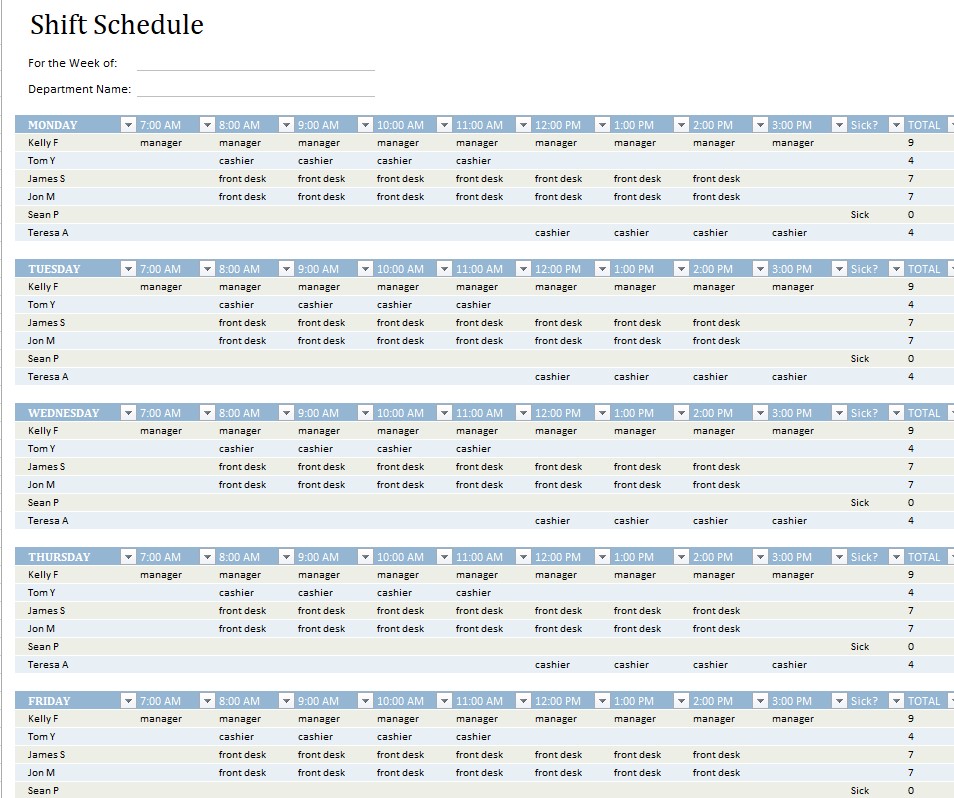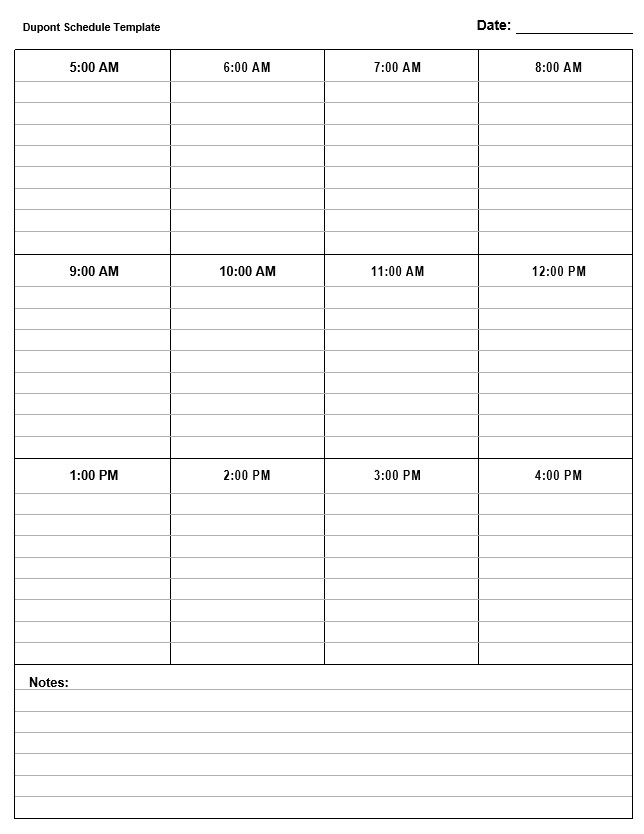Some companies and organizations require their employees to work specific weekly hours and days. Most companies choose the most common schedule: the traditional 8-hour shift and 5 days a week.
However, this common schedule only allows you to cover a part-time shift. Therefore, for this reason, some companies use DuPont schedule templates for more flexible hours. It is a 12-hour rotating schedule. It commonly requires 4 teams, which will be working on two 12-hour shifts. By doing this, the companies will get 24/7 coverage. Let’s learn more about it!
DuPont Schedule Pros
Whether it is a traditional 8-hour shift or a 12-hour shift, it has its benefits. For your information, the benefits and advantages of using the DuPont schedule do not only apply to the employee but also to the employer. Now, consider using this flexible schedule in your company.
- Employees will have more days off. One work cycle consists of four weeks. Using the DuPont schedule allows your employees to have more days off, up to seven days consecutively. Seven days is a lot of time. They can do whatever they want with their family or colleagues.
- Employees get longer breaks. Though working 12 hours might be tiring and painful, they can take a break before their next shifts.
- Employer benefit. A longer break and more consecutive days off will make your employees happier. Happiness can bring advantages to their work. Hence, you will also be satisfied.
DuPont Schedule Cons
For Employees:
- Long Work Hours: Working 12 hours straight can be exhausting. Even with breaks, such long hours can be tough on the body and mind.
- Adjusting to Rotating Shifts: Changing from day to night shifts or vice versa can disrupt one’s body clock, leading to sleep disturbances and health issues.
- Less Time on Workdays: On the day employees are working, they might need more time for personal activities or family due to the extended work hours.
- Potential for Burnout: Even though there are extended breaks, the intensity of 12-hour shifts might lead to quicker burnout.
For Employers:
- Increased Fatigue-Related Mistakes: Longer shifts can lead to tired employees, which might result in more errors, especially towards the end of the shift.
- Staffing Challenges: Not all employees are open to 12-hour shifts, making hiring and retaining staff a potential challenge.
- Training Needs: Due to the unique structure of the DuPont Schedule, employers might need to invest more in training employees to ensure smooth operations.
- Health and Wellness Concerns: With concerns about the health effects of long shifts, employers might face increased health and wellness challenges or even higher healthcare costs.
Things to Consider Before Implementing the DuPont Schedule
Before drawing out your DuPont schedule, you must consider some things first.
Team Size:
- Importance: The DuPont Schedule relies on having enough people to form at least four teams.
- What to Do: Look closely at how many workers you have. This schedule might not be a good fit if the number is higher. If you’re close, consider hiring more people or adjusting the teams differently.
Year-Round Coverage:
- Importance: This schedule ensures workers are always available every hour of every day, all year.
- What to Do: Think about what your company needs. If you need people working all the time, this schedule is perfect. But if you don’t need that, another plan could be better.
Preparing Your Workers:
- Importance: Changing to a 12-hour shift is a big deal. It can be hard on workers if they’re not ready.
- What to Do: Plan carefully. Before making any changes, talk to your workers. Explain why you’re thinking about this new schedule. Listen to their thoughts and worries. Their work time will change, so they must understand and agree.
Training and Tools:
- Importance: Even if everyone agrees, they might need to learn how the new schedule works.
- What to Do: You can find DuPont Schedule templates and examples. These tools will show you and your workers how the schedule runs. Consider having training sessions or meetings to explain things.
Feedback and Adjustments:
- Importance: Even with planning, you might need help with problems when you start.
- What to Do: Keep talking to your teams. Ask them how things are going. If there are issues, think about if you can change things to make it better.
If you have considered the things above, you can search for the DuPont schedule template to give you a picture of how the schedule will work.
Detailed Structure of the DuPont Schedule
The DuPont Schedule, named after the company that first implemented it, is a unique approach to workforce management. At its core, the DuPont Schedule is built on a 12-hour rotating shift pattern. Let’s delve deeper into its structure and functioning.
Foundation of the Schedule: Four Teams
The system revolves around four distinct teams of employees. These teams are the backbone of the schedule, ensuring that every hour of the day is covered.
- Team A
- Team B
- Team C
- Team D
12-Hour Shifts: The Heart of the System
Each team works two consecutive 12-hour shifts, followed by a specific number of days off. It means that while two teams are on duty, covering day and night, the other two are off, allowing them to rest and recharge.
For instance:
- Day 1: Teams A and B might work the day and night shifts.
- Day 2: Teams C and D take over, allowing Team A and B to rest.
The Rotating Nature: Ensuring Fairness
One of the standout features of the DuPont Schedule is its rotating nature. After working their designated shifts, teams rotate their hours. It ensures that every team can handle continuous night shifts. Over a month, each team would have experienced all shifts, from mornings to nights.
The Extended Breaks: An Employee’s Favorite
A notable benefit of the DuPont Schedule is the extended break after the 12-hour shifts. Depending on the rotation, employees get a set number of days off, sometimes a week. This prolonged break is a boon for employees, allowing for genuine recovery, especially after long hours.
Engaging with Employees: A Critical Step
When a company decides to adopt a new schedule, like the DuPont Schedule, it’s not just a shift in timing; it’s a shift in the daily lives of the people who make the company run: the employees. Let’s dive deeper into why engaging with employees is the key to a smooth scheduling transition.
- Trust Through Openness
Change can be scary. When employees hear about a new schedule, many questions arise. “Why now?” “How will this affect my family life?” “Is this going to be harder for me?” Being open about why the change is happening, what it means, and how it can be good can build trust.
- Talk and Listen
Employees should feel that they can speak up. They might have ideas, worries, or questions. Regular meetings, suggestion boxes, or chat sessions ensure everyone gets a say.
- Learn Together
The DuPont Schedule might be new for everyone. Some training can help. Have a few days where people can try it out, ask questions, and get used to it before it starts.
- It’s Okay to Need Time
Big changes don’t feel normal right away. It’s okay if people need time to get used to the new way. Being understanding and giving extra support at the start can help everyone adjust.
- Share the Good Stuff
When good things happen because of the new schedule, share them! Someone has to spend more time with their kids, or teams are working better together. Celebrating the good can make everyone feel positive.
- Keep Checking In
Just because the new schedule starts doesn’t mean the conversation should stop. Keep asking how things are going. There may be small changes that can make things even better. Always be ready to listen and adjust.
DuPont Schedule Templates and Examples
Templates are a great place to begin if you consider using the DuPont Schedule in your workplace. These are ready-made plans that show how to organize worker shifts. You can use them as they are or change them to fit your company’s needs.
DuPont Shift Schedule Monthly
Here’s a visual representation of the DuPont Shift Schedule for four teams over a month:
Green (D) represents the “Day Shift” for Team A.
Blue (N) indicates the “Night Shift” for Team B.
Red (O) signifies “Off” or rest days for Team C.
Purple is a combination of shifts for Team D.
Each team rotates through the day shift, night shift, and off days throughout the month. As you can see, this ensures that there’s always a team available for both day and night shifts, providing 24/7 coverage.
DuPont Shift Schedule for one week.
DuPont Shift Schedule for one week.
The schedule will look something like this in textual format:
Team A: Works from 7 am to 7 pm for 4 days, then off for 3 days.
Team B: Works from 7 pm to 7 am for 4 nights, then off for 3 days.
Team C: Off for the first 3 days, then works from 7 am to 7 pm for the next 4 days.
Team D: Off for the first 3 days, then works from 7 pm to 7 am for the next 4 nights
DuPont 12 Hour Rotating Shift Schedule over 4 weeks
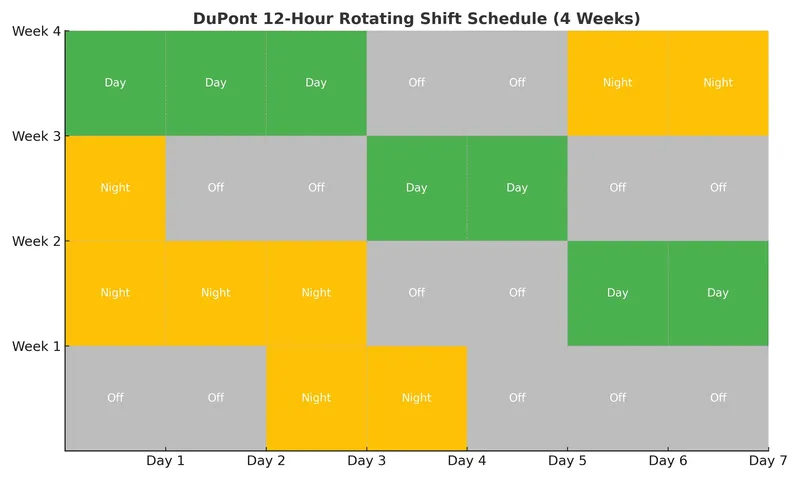
Here’s the visual representation of the DuPont 12-Hour Rotating Shift Schedule over 4 weeks:
Green boxes represent Day shifts.
Amber boxes represent Night shifts.
Grey boxes represent Off days.
5 Week DuPont Schedule
The DuPont Schedule typically operates on a 4-week rotation. Extending it to a 5-week cycle would mean adding an extra week of shifts. This could allow for additional flexibility or to accommodate specific operational needs, but would also complicate the rotation pattern and might be harder for employees to remember.
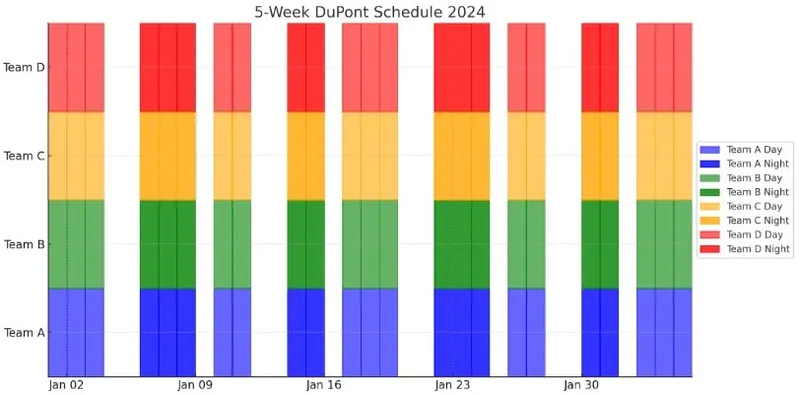
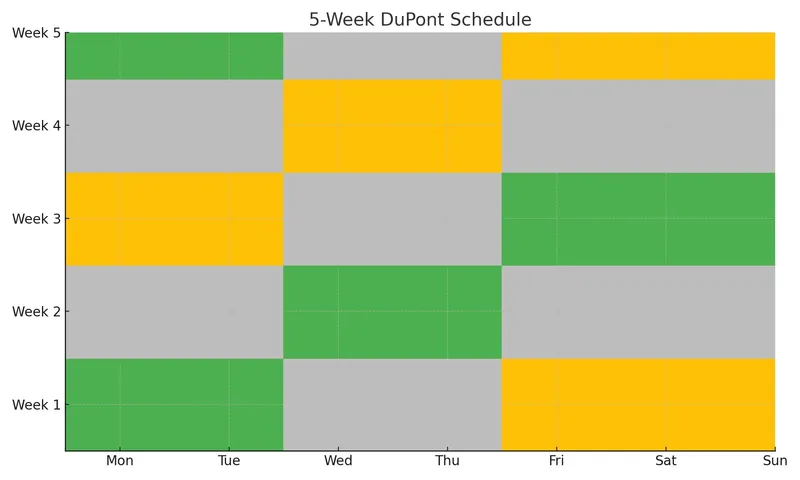
Duration: Covers a 5-week cycle.
Shift Length: Employees work 12-hour shifts.
Rotation: The rotation typically involves both day and night shifts.
Teams: At least four teams are required to cover all shifts and ensure continuous operation.
DuPont 8-Hour Shift Schedule
An 8-hour version of the DuPont Schedule is less common because the original DuPont Schedule is built around 12-hour shifts. However, an 8-hour version would likely involve more teams and a more intricate rotation pattern to ensure 24/7 coverage.
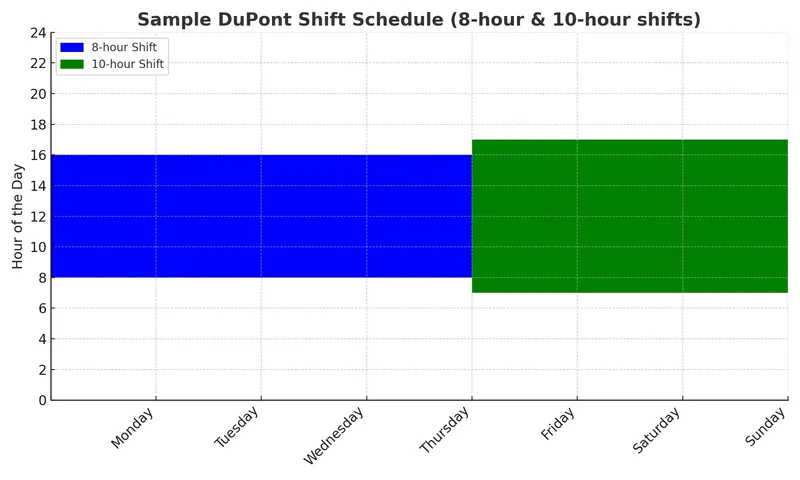
Example:
Team 1: Early shift (6 am – 2 pm)
Team 2: Late shift (2 pm – 10 pm)
Team 3: Night shift (10 pm – 6 am)
The teams would rotate through these shifts, with each team working a particular shift for several days in a row before moving to the next shift.
DuPont Schedule 10-Hour Shift
A 10-hour DuPont Schedule would be a middle ground between the traditional 12-hour and the 8-hour shifts. It would require a different rotation pattern and might be suited for operations that need longer than standard shifts but don’t require a full 12-hour shift.
Example:
Week 1: DDDOO NNOOO
Week 2: OODDD OONNN
Week 3: NNOOD DDDOO
Week 4: OONNN OODDD
(D = 10-hour Day shift, N = 10-hour Night shift, O = Off)
DuPont Schedule for 2024
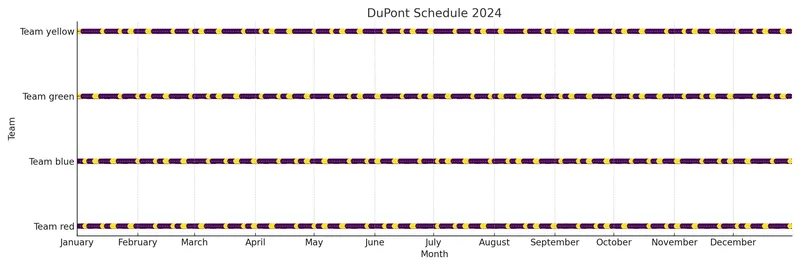
the DuPont Schedule for 2024, based on a 4-team system:
Red, Blue, Green, and Yellow represent the four teams.
Square markers indicate day shifts, while circle markers represent night shifts.
Dupont schedule pay calculator
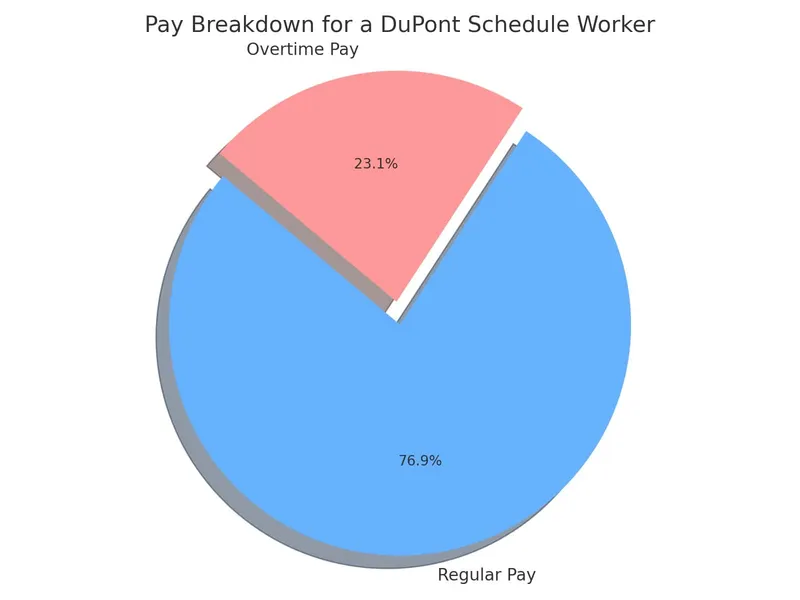
Creating a DuPont Schedule pay calculator requires a few inputs:
Hourly Wage: How much each employee is paid per hour.
Overtime Rate: Typically, this is 1.5 times the hourly wage for hours worked beyond a standard workweek (often 40 hours in many regions, but this can vary).
Hours per Shift: Typically 12 hours for a DuPont schedule.
Shifts per Workweek: This will vary depending on the week in the DuPont schedule cycle.
Additional Bonuses or Deductions: Any extra pay or deductions that need to be considered.
Based on the provided example:
Hourly wage: $20
Hours per shift: 12 hours
Shifts per week: 4
An employee working the DuPont schedule would earn $1040 for the week. This calculation includes the overtime pay (assuming the standard workweek is 40 hours and any time beyond that is compensated at 1.5 times the hourly wage).
Regular Pay: This represents the earnings from the regular hours worked, which is calculated based on the regular hourly wage.
Overtime Pay: This represents the additional earnings from the overtime hours worked, which is calculated using the overtime multiplier (typically 1.5 times the regular hourly wage).
Dupont schedule template excel.
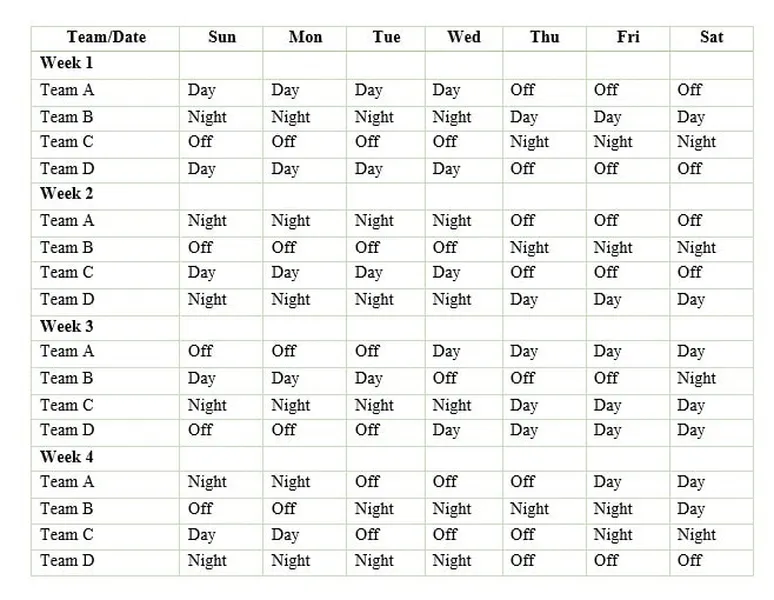
Creating a DuPont Schedule template in Excel involves setting up a spreadsheet that visually represents the 12-hour rotating shifts over the four-week cycle. the process for creating this template:
Setting Up the Spreadsheet:
Create columns for each day of the week (from Sunday to Saturday).
Create rows for each team or group (e.g., Team A, Team B, Team C, Team D).
Filling in the Shifts:
For each team, fill in the shifts (either “Day”, “Night”, or “Off”) based on the DuPont Schedule pattern.
Highlighting Shifts:
Use conditional formatting or manual cell coloring to differentiate between day shifts, night shifts, and off days. This will make it easier to visually understand the schedule.
Adding Additional Features:
You can add features like dropdown lists for selecting teams, date ranges for specifying the month or year, and automatic calculations for hours worked.
Saving and Sharing:
Save the template as an Excel file. You can then share it with other team members or managers and adjust it as needed.
DuPont schedule monthly
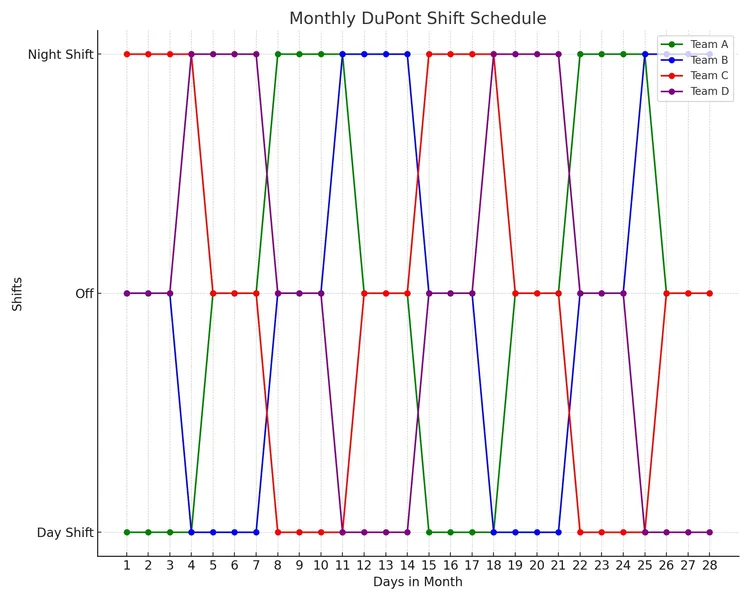
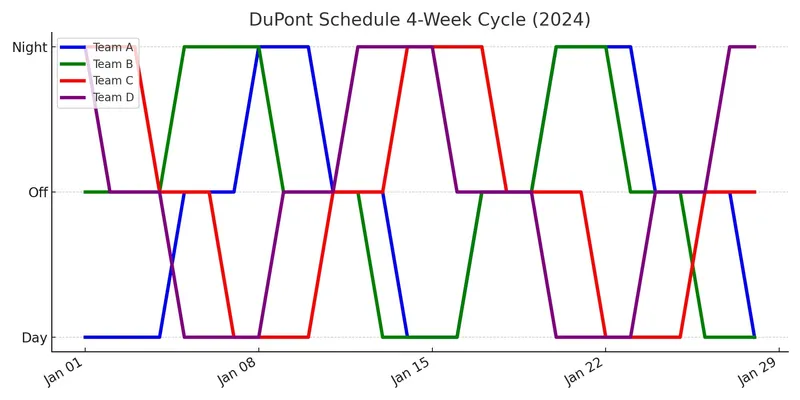
How the DuPont Schedule Works
The DuPont Schedule is a way for businesses to make sure they have workers all the time, every day. Here’s how it works:
- 12-Hour Shifts: Workers have shifts that last 12 hours. It means they work longer each day but get more days off.
- Four Teams: There are four groups of workers. These teams take turns working so that the business never stops.
- Rotating Days and Nights: Workers sometimes work during the day or night. They switch between day shifts and night shifts. It is fair because no one is always stuck working at night.
- Work and Rest Pattern: Here’s an example of how it can work:
- Work 4 days
- Off 3 days
- Work 3 nights
- Off 1 day
- Work 3 days
- Off 3 nights
- Off 4 days, then it starts again.
- Lots of Days Off: Although workers have long days, they get many days off. It can be like a mini-vacation!
- 24/7 Coverage: The business can always stay open because of this schedule. It never has to close because there are always workers.
- Changeover Times: Workers need to know when to come in and when to go home. So, there are set times when one group finishes and the next group starts.
The DuPont Schedule helps businesses that need to be open all the time. But workers and bosses should discuss it to ensure it’s the best plan for them.
Creating a DuPont Schedule: A Step-by-Step Guide
The DuPont Schedule is a rotating 12-hour shift plan that provides 24/7 coverage for businesses. Follow these steps to create an effective DuPont Schedule:
Determine Your Needs:
- Assess if your business requires 24/7 coverage.
- Understand the total number of employees available for scheduling.
Divide Employees into Teams:
- Typically, the DuPont Schedule requires four teams. Divide your employees into these teams.
- Make sure each team has a mix of skills to handle all tasks.
Set the Rotation:
- Assign each team to a specific rotation in the schedule. For example, Team A might start with day shifts while Team B starts with night shifts.
- The common rotation is four days/nights on, followed by three days off. Later in the schedule, they work three days/nights on, get a day off, and then work another three days/nights, followed by three days off.
Ensure Fairness in Rotation:
- Ensure that each team rotates between day and night shifts to distribute the burden of night shifts fairly among all employees.
Plan for Breaks:
- Given that employees work 12-hour shifts, plan adequate break times within the shifts to ensure they can rest and recharge.
Communicate the Schedule:
- Once you’ve created the schedule, communicate it to all employees. Make sure they understand how the rotation works and the benefits it offers.
Gather Feedback:
- After implementing, gather feedback from employees. Understand any challenges they might face and be open to making necessary adjustments.
Review and Adjust:
- Continuously monitor the schedule’s effectiveness. Make necessary adjustments based on operational needs and employee feedback.
Consider Using Software:
- Scheduling software solutions can automate the creation and management of the DuPont Schedule, making the process more efficient.
Stay Compliant:
- Check with local labor laws to ensure your schedule complies with regulations regarding overtime, breaks, and more.
Remember: Implementing a DuPont Schedule is not just about assigning shifts. Regularly reviewing and adjusting the schedule as needed can ensure its long-term success.
Some Facts About the 12-Hour DuPont Shift Schedule
The DuPont Shift Schedule has become a topic of interest for many companies. But what is it all about? Let’s explore some facts.
- No Staff Cuts: Using the DuPont Schedule doesn’t mean cutting staff. Everyone still works, just at different times.
- Same Weekly Hours: Even though each workday is longer, the total hours a person works each week doesn’t change much.
- Adjustment Time: Shifting from 8-hour days to 12-hour days can be a big change. Some people need time to get used to it.
- Bigger Paychecks?: Studies have shown companies might pay about 2% more in wages with this schedule.
- Better work Done: With fewer shift changes, some tasks can be finished faster.
- More Rest Days: This schedule often gives workers more days off.
- Health Matters: Longer workdays can be tiring. Companies need to watch and make sure workers are energized and healthy.
- Not For Everyone: While many people can adjust, some might find the longer hours too hard.
- Job Type Matters: 12 hours at a desk might be okay. But 12 hours of heavy lifting or running around might be too much.
- Talk to the Bosses: It’s not just workers who need to adjust. Managers and supervisors need to be on board, too.
The DuPont Schedule can be a good thing for some companies. But, like all things, it has its pros and cons. It’s essential to think it through and talk to everyone involved.
Common Mistakes in Implementing the DuPont Schedule
When using the DuPont Schedule, people sometimes need to correct things. Here are some of them:
- Need More Training: Some companies need to train workers about this schedule. It can make things confusing.
- Not Talking Enough: Companies must explain why they use the DuPont Schedule. It can make workers unhappy.
- Being Too Strict: Some companies keep the schedule the same despite problems. It can upset workers.
- Not Listening: Companies should listen to what workers say about the schedule. If they don’t, workers might not like their jobs.
- Not Watching Health: Workers do long shifts in this schedule. Companies should make sure they’re okay and not too tired.
- Changing Too Much: It can be hard for workers to follow if companies keep changing the schedule.
- More Breaks: Workers should get breaks during their long shifts. If not, they can get very tired.
- Not Fair with Night Shifts: Some workers might do more night shifts than others. It isn’t fair.
- Not Ready for Sick Days: The company should have a plan if a worker is sick and can’t come in. If not, it can mess up the schedule.
- Not the Right Fit: Sometimes, this schedule could be better for the company. Companies should think about if it’s right for them.
To make the DuPont Schedule work, companies should plan well, talk with workers, and check if things are going okay.
Conclusion
The DuPont Schedule is different, but that’s a good thing. It offers a new way to think about work time. Companies can keep running all day and night. Workers get a different kind of balance between work and rest. As the world of work changes, new schedules like this can help companies stay strong and workers stay happy.
FAQs
What’s the DuPont Schedule Template?
It’s a ready-made plan for a 12-hour shift pattern. Companies use it to keep their places open all day and night with four groups of workers.
Why the name “DuPont Schedule”?
The DuPont Company made this schedule famous. They used it first, and then other places started using it too.
How is it different from an 8-hour workday?
Most places have 8-hour workdays for five days. With the DuPont plan, people work 12 hours. They might work in the day or night. But they also get more days off in a row.
Is it good for all jobs?
Not all places. It’s great for jobs that always stay open. But each place should think about if it’s right for them.
How do workers get used to 12-hour days?
Starting with 12-hour days may take a lot of work. But getting more days off can be nice. Companies should help workers get used to it.
Can we change the DuPont Template?
Yes, you can! The plan is a starting point. But each place can make little changes if they need to.
Is working 12 hours safe for workers?
Long workdays can be tough. Places should let workers take breaks and check if they’re okay.
Do workers like having many days off?
A lot of workers like it because they get long breaks. But everyone is different.
How do the day and night shifts switch in this plan?
Workers change from day to night shifts and back. This way, no one is always working at night.
Does this plan save companies money?
It can help some places stay open all the time. But, companies should think about costs, like paying extra for long days.

The content creator team at calipsotree.com is dedicated to making topics accessible to everyone, with over 9 years of experience in writing and breaking down complex concepts into easy-to-understand articles that answer readers’ financial questions.






